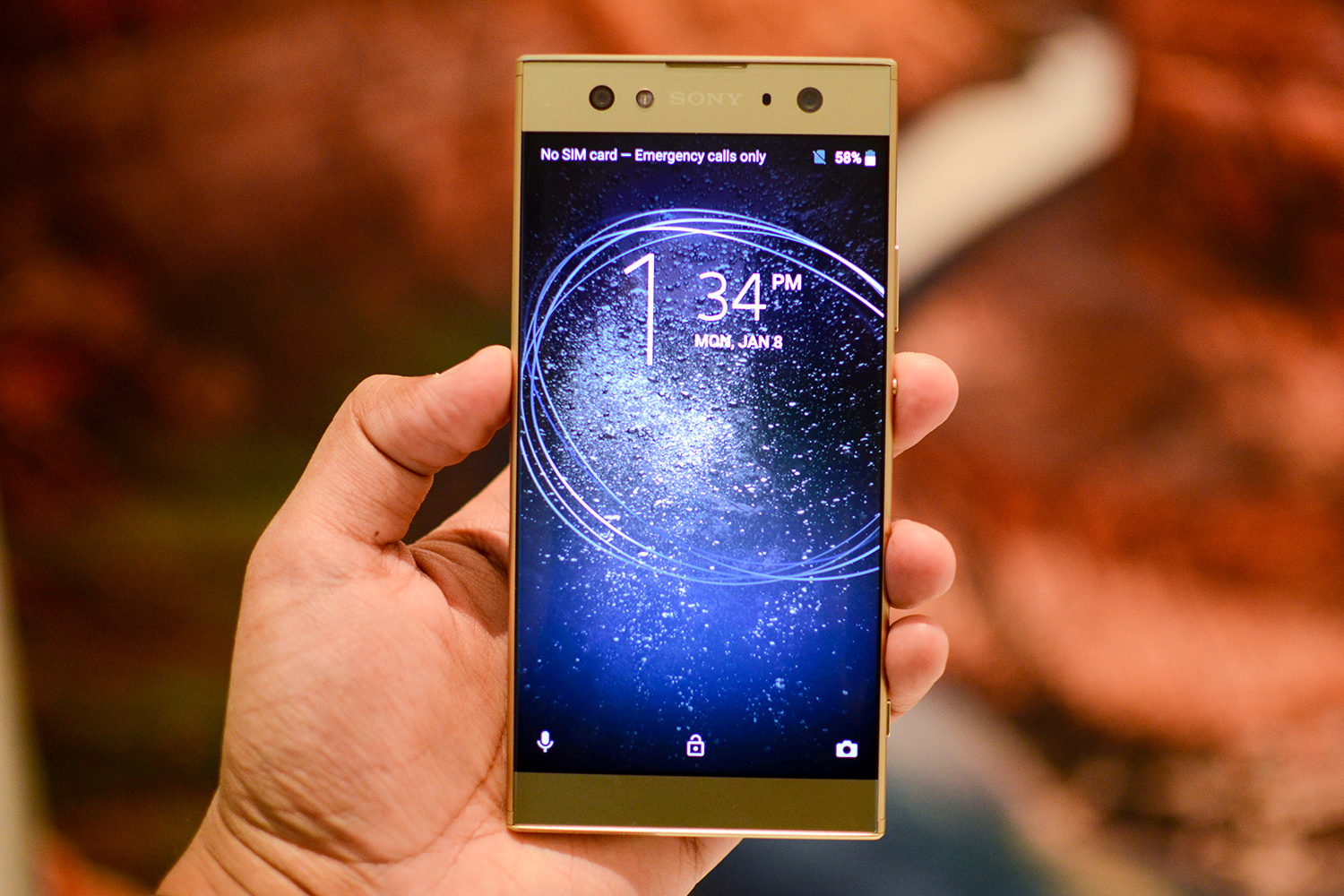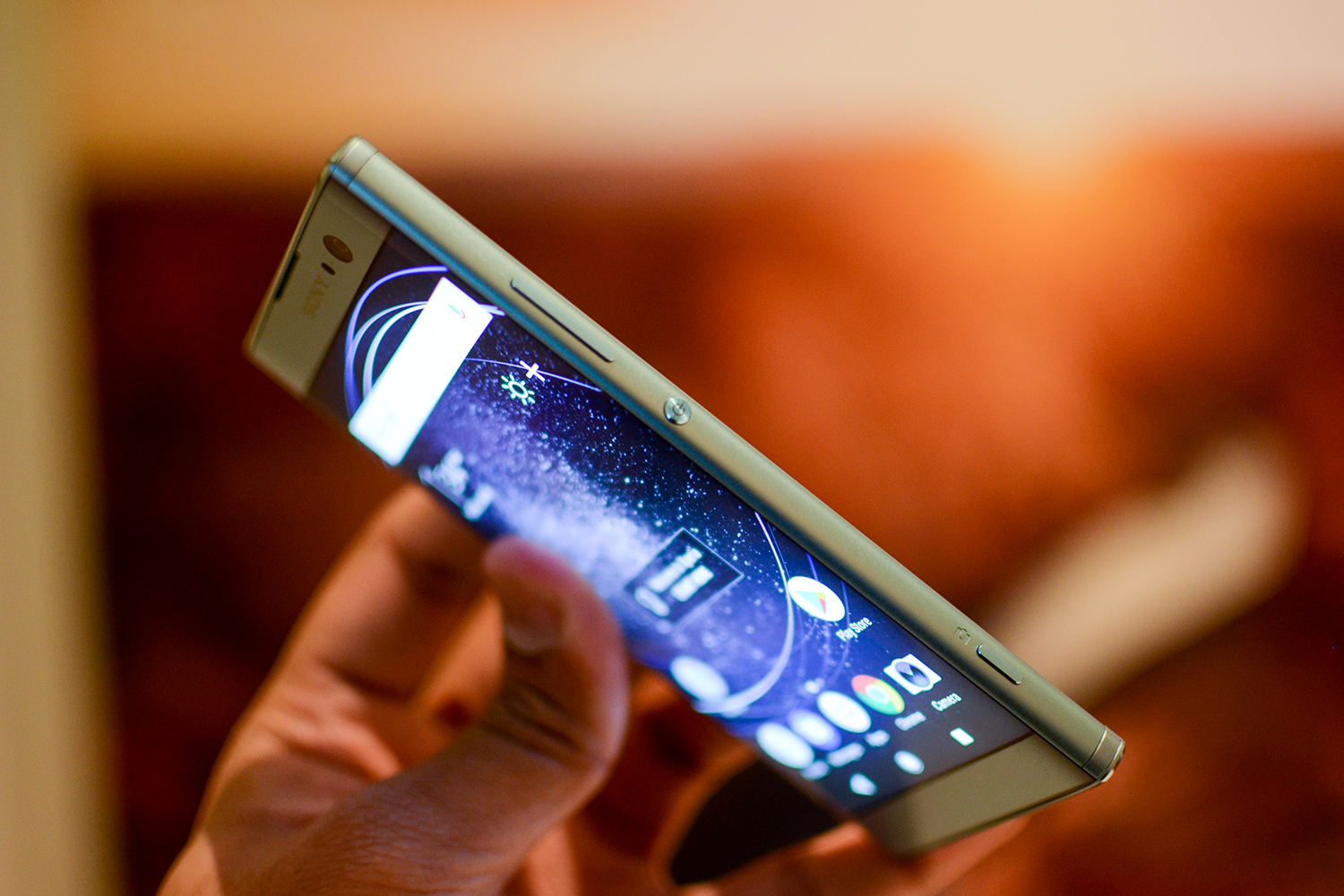While the L2 and the XA2 are average Android budget smartphones, the XA2 Ultra has some interesting additions that may indeed make it a smartphone worth considering when it launches towards the end of January or early February. We dive into all three smartphones in our Sony Xperia XA2 Ultra, XA2, and L2 hands-on review.
Xperia XA2 Ultra
The Xperia XA2 Ultra is a midrange phone, so don’t mistake it for the flagship Xperia XZ1 or XZ1 Compact series that launched late last year. It feels large in the hand because of its 6-inch size, but unlike other 6-inch phones we’ve seen in 2017 — such as the Galaxy S8 Plus or the LG V30 — it doesn’t quite follow the “bezel-less” trend, with minimized edges around the screen.
To be fair, the bezels have shrunk if you compare the XA2 Ultra to the XZ1 Compact. There are almost no bezels on the sides of the screen, and Sony has shrunken the top and bottom edges. They’re still a tad chunky that what we’re now used to, but it doesn’t look as dated as Sony’s previous devices. The rest of the phone is quite familiar. The circular power button sits on the right edge, below the volume rocker. On the same edge, you’ll also find a dedicated camera button, which sits in a natural position when holding the phone in landscape mode for photos.
The biggest redesign is apparent on the phone’s rear. Below the circular single-lens camera sits a fingerprint sensor. That may not sound like a big deal, but Sony has traditionally placed its fingerprint sensors on the edge of the phone, below the power button. What’s more is this fingerprint sensor will finally be activated and ready to use on devices sold in the U.S. In the past, Sony hasn’t activated the fingerprint sensor on its U.S. phones due to “business decisions,” but it seems as though the company has finally changed its mind. It’s a good step in the right direction, but we’re sad it took Sony so long to make this a feature standard.
The second-most-visible change is on the front top bezel — you’ll find two selfie cameras. One is a 16-megapixel camera with optical image stabilization, and this is the main lens you’ll use to capture most selfies. The additional 8-megapixel camera is a 120-degree wide-angle lens that’s helpful for group photos, and when you want more of the background in the shot. Switching between both lenses is fast, and the phone seemed to capture images quickly without visible shutter lag. We haven’t played around with the cameras enough to make a verdict on the quality of these photos, but we were satisfied with what we saw.
Accompanying these two front cameras is a slow-sync flash, and it’s the other cool trick the XA2 Ultra offers over the competition. Traditionally if you’re in a dark environment like a nightclub, and you try to take a selfie with the flash of the screen or a front-facing flash, only you would be illuminated and the background would be completely dark — not ideal if you want to show where you are. The XA2 Ultra’s slow-sync flash solves the problem by lighting up the selfie-taker and the background, so everything is relatively visible. We tried this out in an incredibly dark room, and the results were surprisingly good.
These front-facing cameras are really the highlight of the XA2 Ultra. Other than that, the phone is powered by a Qualcomm Snapdragon 630 processor with 4GB of RAM, runs Android 8.0 Oreo, and has a Full HD display. We didn’t notice any issues with performance as we swiped through the home screens and opened multiple apps, but we’ll have to do more testing. The software experience was relatively close to stock Android, but we did notice there were a lot of preinstalled apps from Sony. How’s the display? It didn’t stand out. At 6 inches, the screen didn’t feel particularly sharp with a 1080-pixel resolution, but most people will be satisfied.
You get the option of 32 or 64GB of storage as well as a MicroSD card slot if you need more space; and there’s a large 3,580mAh battery that’s charged via the USB Type-C port. The XA2 Ultra has Bluetooth 5 on board, and it supports AptX HD, a high-quality audio protocol.
The rear camera is worth noting as well. It’s a large, 23-megapixel camera that has an impressive 12,800 ISO, meaning the phone may be able to capture good low-light photographs — though with quite a bit of noise. We’ll have to test this to see how the XA2 Ultra performs, but we didn’t notice much shutter lag, and the quality of the photos were solid.
We’re not sure yet how much the Xperia XA2 Ultra will cost, but it will be available in silver, black, blue, and gold toward the end of January. Price will really influence our opinion on this phone, and we’re hoping it will be $400 or under.
Xperia XA2
Take mostly everything we talked about the XA2 Ultra, shrink it down a few inches, and you have the Xperia XA2. It’s significantly smaller at 5.2-inches, and is comfortable in the hand. The fingerprint sensor on the rear is well-placed, and its design is the same angular look we’re familiar with the Xperia line. Both the XA2 and XA2 Ultra feature metal builds that feel quite high-end, and the left and right bezels are again incredibly slim.
It also runs Android 8.0 Oreo with the Snapdragon 630, but the XA2 only has 3GB of RAM instead of 4GB. The screen is the same 1080-pixel resolution, but it’s sharper than the XA2 Ultra because of the smaller screen size. The rear 23-megapixel camera is the same, but on the front you’ll only find one 120-degree, wide-angle, 8-megapixel camera. There’s only 32GB of storage available, but there is a MicroSD card slot, and the battery capacity is 3,300mAh.
We like the form factor of the XA2 over the Ultra, but we’d have loved to see the same slow-sync technology to help improve low-light selfies. This phone will be even more affordable than the Ultra, and it will be available around the same time toward the end of January. It’s coming in silver, black, blue, and pink.
Xperia L2
The Xperia L2 is the runt of the litter, and that’s easily identifiable in the phone’s design and build quality. The body is made of a plastic-type material, and it felt quite cheap in the hand. The bezels around the 5.5-inch screen were fairly chunky, and the it easily looks dated. This is not an attractive phone.
It’s incredibly thick, and the back is slightly curved. It’s lacking the dedicated camera button, but everything else design-wise is fairly similar to the XA2 and XA2 Ultra.
The L2’s processor is likely from MediaTek, as Sony only said it’s a quad-core 1.5GHz chip, with 3GB of RAM, and it oddly runs Android 7.1.1 Nougat. It’s unclear when Sony will upgrade it to the 2017 Android 8.0 Oreo.
The rear camera is rated at a 13-megapixels, but you’ll find the same 120-degree, wide-angle, 8-megapixel front-facing camera. The 5.2-inch screen only has a 720-pixel resolution, and it was just average. The phone supports Bluetooth 4.2, has 32GB of storage with a MicroSD card slot, and there’s a 3,300mAh battery that should provide great battery life. No price has been announced yet, but it’s also expected to launch at the end of the month.
The L2 is the least impressive phone of the lot, but if the price is right, it could be an excellent budget phone that could give phones like the Moto E4 Plus a run for its money.



















